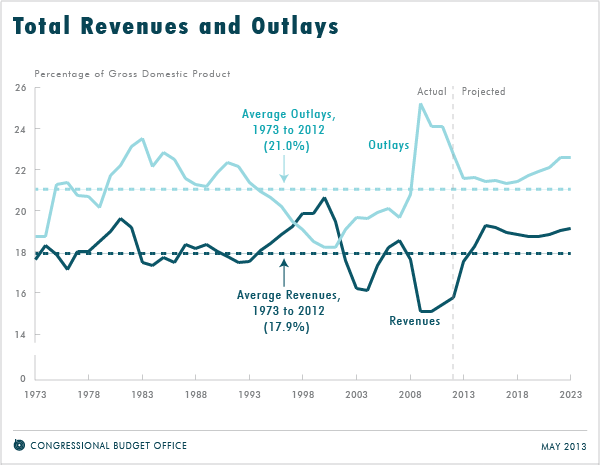
Not only is the deficit expected to shrink significantly this year, but it is expected to decline to $378 billion or 2.1% of GDP in 2015. The publicly-held national debt is expected to peak at 76.2% in 2014, fall to a low of 70.8% in 2018 and then begin to rise again. Does this mean that the budget deficit is no longer a problem?
The CBO also released deficit and debt estimates under an alternative scenario. Why an alternative scenario? The CBO must base its forecasts on current law. That means it must assume that sequestration will continue to be implemented over the next decade, reimbursements to doctors under Medicare will be cut, and some temporary tax provisions will be allowed to expire. Will this happen? It's hard to know for sure, but there's a good chance a lot of it won't. If it doesn't, deficits will be significantly higher (link to excel file with the alternative deficit forecasts). For example, instead of declining to $378 billion in 2015, the deficit would be $577 billion or 3.3% of GDP (almost $200 billion higher). The publicly-held national debt would fall to 75% of GDP in 2017 before rising to 83% in 2023 (compared to 74% in the baseline scenario). Over the decade (2014-2023), the debt would be $2.4 trillion higher under the alternative scenario.
Where does the US stand in terms of the budget deficit and national debt? The budget deficit is falling. Of course policies designed to reduce the deficit cause short-term economic pain (tax hikes, sequestration, ...). Given the progress already achieved in terms of deficit reduction and the continued modest recovery, future efforts should focus on long-term reductions in the deficit (for example, entitlement reform). The baseline forecast assumes that there will be significant cuts in discretionary spending in the years ahead that may be politically difficult (and may not be the best approach to reduce the deficit). If these cuts are not implemented, alternative means of controlling future spending will be necessary (further action will be necessary even if most or all of these cuts are implemented). For further details, see this post from late 2012.